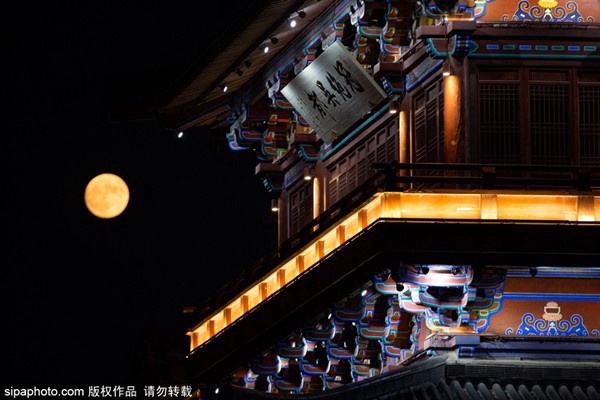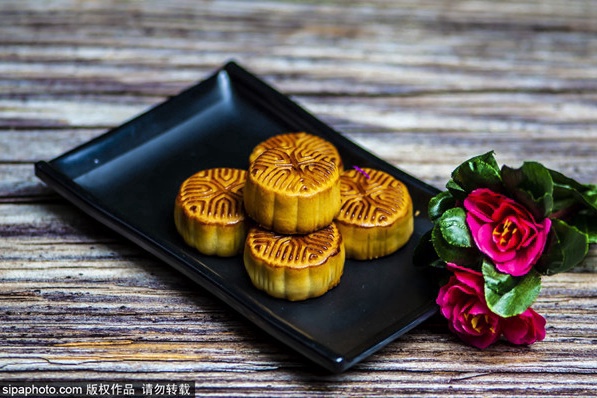On October 1, 2020 (the 15th day of the 8th lunar month), we will usher in the Mid-Autumn Festival. The Mid-Autumn Festival is the second most important festival in China after the Spring Festival. In China, it is a reunion time for families. People celebrate it by lighting lanterns, appreciating the moon, and eating mooncakes.

The term "Zhongqiu"(Mid-Autumn) was first seen in theBooks of Rites: Proceedings of Government in the Different Months.
When it came to the Zhou Dynasty, events were held every year on the night of the Mid-Autumn Day to meet the cool air and worship the moon. The celebration on the Mid-Autumn Day is much more about the good harvest. Thanks to the ancient sacrificial culture and agricultural history, it carries a lot of Chinese cultural connotations. The Mid-Autumn Festival began in the early Tang Dynasty and prevailed in the Song Dynasty. By the Ming and Qing dynasties, it has become one of the most important Chinese traditional festivals. The Mid-Autumn Festival, also known as the
Moon Dusk, Autumn Festival, Zhongqiu Festival, Eighth Month Festival, Eighth Month Gathering, Chasing Moon Festival, Playing Moon Festival, Praying Moon Festival, Daughter's Festival, or Reunion Festival, is proved to be popular with the public.
Origins and Legends of the Mid-Autumn Festival
There are a lot of legends about the Mid-Autumn Festival, like the well-known Chang'e Flying to the Moon, Wu Gang Cutting Sweet Osmanthus Tree, and Jade Rabbit Mashing Herbs.
Legend One: Chang'e Flying to the Moon
According to legend
, once in ancient times, ten suns rose in the sky. Crops were dying and people were suffering. A hero named Hou Yi felt sympathy for the people and shot down nine suns, leaving just one sun rising and falling on time to benefit the people.
Hou Yi was therefore respected and adored by people, and he married a beautiful and virtuous wife named Chang'e. In addition to imparting skills and hunting, Hou Yi was always with his wife, and people admired at the beloved couple.
Many people came here for guidance and the dishonest Peng Meng also lurked in them.
One day, Hou Yi went to visit friends and seek methods in Kunlun Mountains. He encountered the Queen Mother of the West passing by the Kunlun Mountains, so he asked for a pack of the elixir. It was said that the elixir could make a person become an immortal instantly. However, Hou Yi was unwilling to leave his wife, and he gave the elixir to Chang'e for safekeeping. Chang'e put the elixir into a case of her dressing table, which was seen by Peng Meng who was very treacherous. He wanted to take the elixir and become an immortal.
Hou Yi led his apprentice to go hunting three days later while Peng Meng pretended to be ill for staying home. Shortly after Hou
Yi and his apprentice left, Peng Meng broke into Hou Yi's house with a sword and threatened Chang'e to hand over the elixir. Chang'e knew that she could not knock down him, so she turned to open the case, took out the elixir, and made a prompt decision to swallow it in the critical time. After swallowing it, her body immediately floated off the ground and out of the window, and flew to the sky. Chang'e was concerned about her husband, so she flew to the moon which is the closest to the earth, and became an immortal.
In the evening, Hou Yi returned home and the maids wept out what was happened during the day. Hou Yi was astonished and angry, and drew his sword to kill the villain. However, Peng Meng ran away early. Hou Yi beat his breast in agony and looked up at the dark sky, calling his wife's name. Then he was surprised to find that the moon was extraordinarily bright and a swaying figure seemed to be Chang'e. He tried his best to go after the moon, but the moon was always beyond his grasp, no matter what he did.
Hou Yi was in desperation. He missed his wife so much that he asked his maids to put an incense table in the back garden, which was the favorite place for Chang'e, and put desserts and fresh fruits which were the favorite food for Chang’e on the table, holding a memorable ceremony for Chang'e who lived in the distant Moon Palace and missed him the same. When the people heard that Chang'e flew to the moon and became an immortal, they all arranged incense tables below the moon for the worship of virtuous Chang'e, praying for happiness and safeness.
Since then, worshipping and appreciating the moon during the Mid-Autumn Festival has become popular.
There is another legend about the Mid-Autumn Festival. It is said that there was a luxuriant osmanthus tree with over 500zhang
(about 1666.7 meters) in front of the Moon Palace on the moon, and there was a man cutting the tree. But the problem was that each time he cut the tree, it would instantly grow back.
For thousands of years, whenever he cut, the wounds of the tree healed simultaneously, and the tree would never be cut down. According to the story, the man was Wu Gang, a disciple of an immortal, and came to heaven for studying. But he made a mistake and was sent to the Moon Palace to do such endless toil as a punishment.
It is said that Chang'e had an adorable jade rabbit. When Chang'e began to go up, she was scared to seize something to keep down. Therefore, she picked up the white rabbit she was feeding, but the rabbit could not keep her and accompanied her to the moon, which adds the adorable and warm atmosphere for the legend. In the Moon Palace, Jade Rabbit had a pestle and mashed the elixir in the mortar at night. In the long run, the legend "Jade Rabbit Mashing Herbs" came into being.
Legend Four: The Mooncake Uprising
The tradition of eating mooncakes on the Mid-Autumn Festival is said to begin in the Yuan Dynasty. At that time, the Chinese people were tortured by the cruel Yuan government, which prompted a nationwide rebellion. Zhu Yuanzhang united the different resistance forces and proposed for an uprising. But it was difficult to convey his orders, as the raids by government forces were intense. Liu Bowen, a strategist of Zhu's troops, came up with the idea of hiding notes containing the date of the uprising in mooncakes and distributing them to rebels, informing the rebels to uprise on the night of August 15 of the Chinese lunar calendar. On the very day, the rebels responded to the uprising with an inexorable trend.
Soon, Xu Da took the capital of the Yuan Dynasty, marking the success of the uprising. When the news came, Zhu Yuanzhang was so happy that he ordered the soldiers to share the happiness with the people on the upcoming Mid-Autumn Festival, and awarded his subjects with the mooncakes used to convey messages during the uprising as seasonal cakes. Since then, mooncakes have been more and more exquisite with many varieties. Some are even as large as round plates. They have become a good choice of gifts.
The Customs of Mid-Autumn Festival
Appreciating the moon.

China has a custom of appreciating the moon in the Mid-Autumn Festival since ancient times. There is the custom of worshipping the Moon God at nightfall in autumn, according to theBook of Rites.
When it came to the Zhou Dynasty, events were held every year on the night of the Mid-Autumn Day to meet the cool air and worship the moon. On the event, an incense table was arranged, offering mooncakes, watermelons, apples, plums, grapes, and other seasonal fruits, among which the mooncake and the watermelon were essential. The watermelon should be shaped as a lotus.
Appreciating the moon in the Mid-Autumn Festival became quite popular in the Tang Dynasty.
In the Song Dynasty, it became more popular. According to theEastern Capital: A Dream of Splendor
, "On the night of Mid-Autumn Festival, the rich would decorate the pavilion; the public would get to the restaurant to appreciate the moon."
On that day, all the stores and restaurants would make decorations and offer fresh fruits and exquisite food. The night fair was bustling. Most of the people would get to the high building. Some rich families would appreciate the moon and food in their own pavilions or arrange the family dinner to reunite family members and have a chat under the moon.
After the Ming and Qing Dynasties, the custom remained, and many places have other special customs such as burning the tower-shaped incense, hanging lanterns, lighting up tower lights, flying sky lanterns, walking under the moonlight, and performing fire dragon dance.
Eating mooncakes.

It is the custom to eat mooncakes in the Mid-Autumn Festival. As the saying goes, "The moon on the 15th day of the 8th lunar month is round; the mooncake tastes sweet in the Mid-Autumn Festival." The mooncake was originally the sacrifice to worship the Moon God. Later, people gradually combine the moon appreciation with mooncake tasting, which means family reunion. In the Mid-Autumn Festival, it is necessary to eat mooncakes for the celebration.
Lighting a lantern.
On the night of the Mid-Autumn Festival, it is the custom to light a lantern for the moonlight. At present, the custom of lighting a lantern over the tower which is piled up by tiles exists in Hunan and Hubei.
The custom of making lantern boats prevails in Jiangnan.
In modern times, the custom of lighting a lantern in the Mid-Autumn Festival becomes more popular.
Today, Zhou Yunjin and He Xiangfei said in theTalking about Seasons in Leisure
, "Guangdong has the most lanterns. Every family uses bamboo sticks to make lanterns ten days before the festival.
They will make the various shapes of lanterns, including the shape of fruits and food, birds and animals, fish and insects, as well as the character of 'Happy Mid-Autumn Festival', and the lanterns will be painted with different colors. The candle within the lantern is tied to the bamboo pole and the lantern will be held on the tile eaves or terraces; or the small lanterns will be built like the shape of Chinese characters or other shapes, and then was put on the high place of houses. It is colloquially named 'hanging lanterns'.
The lantern in the rich family can be up to severalzhang
and family members can enjoy the gathering under the lantern. The ordinary people will erect a flagstaff with two lanterns to celebrate it.
The city full of lanterns looks like the World of Medicine Buddha." The scale of the lighting lanterns in the Mid-Autumn Festival is second to that of the Lantern Festival.
Guessing lantern riddles.
In the past, every family would hang up the colorful lanterns and set off fireworks on the 15th day of the 8th lunar month. People would write lantern riddles on the lanterns, or tie them to the lanterns. Later, some wrote the riddles on the scrip and put it on the colorful lanterns for guessing. Guessing riddles can inspire and enlighten people and cater to the festive atmosphere, which enhances the pleasure of appreciating the lanterns. Then, guessing riddles gradually becomes a necessary game for the lantern fair in the Mid-Autumn Festival.
Now, many stores are hanging the riddles in the Mid-Autumn Festival and the visitors will get a prize if solving the riddle. This year, you might as well try it.

At the full-moon night of the Mid-Autumn Festival, you can know about the mood of ancient people and continue the tradition. So what are you going to do in the Mid-Autumn Festival this year?



